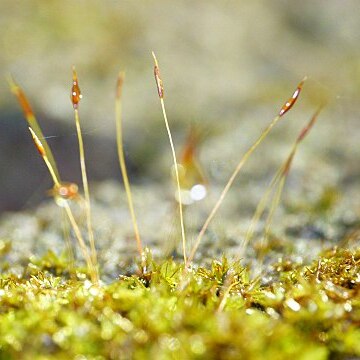Plants small to medium, in loose tufts, blackish green to dark green; saxicolous. Stems 5-15 mm tall; in section round, central strand present, inner cortical cells thin-walled, becoming smaller toward margin, incrassate, reddish. Leaves glossy, incurled with involute margins dry, spreading with plane margins wet; broadly oblong to elliptical, 2-4 mm long; apex broadly acute, mucronate; margins plane, serrate to dentate in upper leaf. Costa subpercurrent to short-excurrent, ventral superficial cells quadrate, mammillose, dorsal superficial cells rectangular, smooth, incrassate; in section round to oval, guide cells 4, small, ventral stereid band small, 2-3 cells thick, ventral surface cells thickened, bulging, dorsal stereid band large, 2-6 cells thick, dorsal surface cells substereids. Upper laminal cells small, hexagonal to subhexagonal or rounded, becoming quadrate below; in section ventral surface mammillose, dorsal surface smooth; basal cells rectangular, smooth. Gemmae infrequently produced, axillary, stalked, multicellular, polymorphous. Dioicous. Perichaetia terminal, leaves undifferentiated. Seta erect, to 8 mm long, yellowish; capsule cylindrical, 1.5-1.8 mm long, brownish; peristome absent; operculum rostrate, 0.8 mm long; calyptra cucullate; spores round, 10-13 µm, smooth.
More
Plants in loose or dense, dark green to red-brown or blackish tufts, dull or occasionally with a metallic sheen. Stem densely foliate, 5-10(-20) mm, central strand strong. Leaves concave when moist, to 1.5-2(-2.5) mm, oblong-spatulate to obovate, occasionally with multicellular teeth in distal 1/4, rounded to rounded obtuse at the apex, sometimes apiculate; costa stout, prominent abaxially, smooth on the abaxial surface to occasionally roughened at the apex, hydroids absent; laminal cells near insertion short-rectangular, 2-4:1, firm-walled, pale and brownish or hyaline, cells 8-10(-12) µm wide, in longitudinal and oblique rows, thin to thick-walled, bulging-mammillose on the adaxial surface, plane on the abaxial. Sexual condition dioicous. Seta 6-7 mm, reddish to yellow-brown with age. Capsule erect, 1.5-3 mm, narrowly cylindric from an indistinct neck, annulus well differentiated, red-brown, of vesiculose cells, persistent or deciduous; [operculum erect, conic-rostrate, 0.6-0.8 mm].

